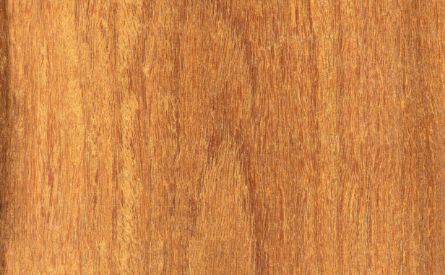CUMARU
Almendro / Dipteryx spp.

Local Names
Tonka, Sarrapia, Charapilla, Cumarut, Eboe, Shihuahuaco Amarillo.
Distribution & Tree
Cumaru is endemic to Central America and through the Amazon Basin. In Guatemala, it’s referred to as almendro de montaña, literally mountain almond. In Izabal, it tends to occur in steeper montane forests. It develops well on sandy soils and tolerates clayey and acidic conditions. The tree grows up to 40 meters in height and upwards of 100 cm in diameter.
Wood Appearance
When freshly cute, the heartwood is reddish to purplish brown with brown or purplish streaks. Upon exposure, it gradually becomes a light or yellowish brown. Its sapwood is distinct. Cumaru has a medium luster, a fine texture, and interlocked grain. The wood has an oily or waxy feel.
Processing Properties
Due to high density and silica content, the wood is difficult to saw and bore, especially with hand tools. Unless the grain is particularly interlocked, it planes to a smooth surface. Because of its high density and oily nature, it glues poorly. Stellite-tipped and tungsten-carbide cutting equipment is recommended.
Strength & Durability
The wood is highly durable to brown-rot and white-rot fungi with excellent weathering properties. It’s highly durable to termites and holds up well when buried and in contact with fresh water. It is resistant in seawater and in the presence of marine borers.
Wood Uses
Heavy construction, decking, railroad ties, ship planks and decks, seawater hydraulic works, bridges, cogs and shafts, truck bodywork, barge and dock fenders, flooring, pulp-mill equipment, tool handles, bearings, and turnery. It can be used for veneer. Due to its durability, cumaru is proposed as a substitute for lignumvitae.
Ecological & Social Importance
Cumaru produces the tonka bean, a vanilla-cinnamon scented seed whose active ingredient, coumarin, has been used in perfumes and cuisine for over two hundred years. The green macaw, threatened in Costa Rica, nests in its branches. As a consequence, the tree’s harvest is restricted in the country.
| Reference Species | ||||
| Technical Characteristics | Cumaru | Ipê | Hickory (Shagbark) | |
| Density | kg/m3 | 1,041 | 1,100 | 800 |
| Janka Hardness | kgf | 1,411 | 1,592 | 853 |
| Bending Stiffness (Modulus of Elasticity) | GPa | 22.3 | 22.1 | 14.9 |
| Bending Strength (Modulus of Rupture) | MPa | 175.1 | 177.0 | 139.3 |
| Crushing Strength | MPa | 95.5 | 93.8 | 63.5 |
| Shrinkage, Radial | % | 5.3% | 5.9% | 7.0% |
| Shrinkage, Tangential | % | 7.7% | 7.2% | 10.5% |
| Shrinkage, Volumetric | % | 12.6% | 12.4% | 16.7% |
| T/R Ratio | 1.5 | 1.2 | 1.5 | |
| Values determined at 12% humidity - Provided for reference only | ||||
|---|---|---|---|---|
DENSITY
JANKA HARDNESS
BENDING STIFFNESS
BENDING STRENGTH
CRUSHING STRENGTH
SHRINKAGE
Values are for reference only and cannot be guaranteed. Wood is a natural material and physical and mechanical properties may vary depending on age, genetics, and other factors. We encourage customers to consult the references provided in the bibliography. For further explanations of wood’s key technical characteristics, an excellent resource is the Wood Database with articles on Density (average dried weight); Janka hardness; Elastic Modulus; Rupture Modulus; Crushing Strength; Radial, Tangential and Volumetric Shrinkage.






